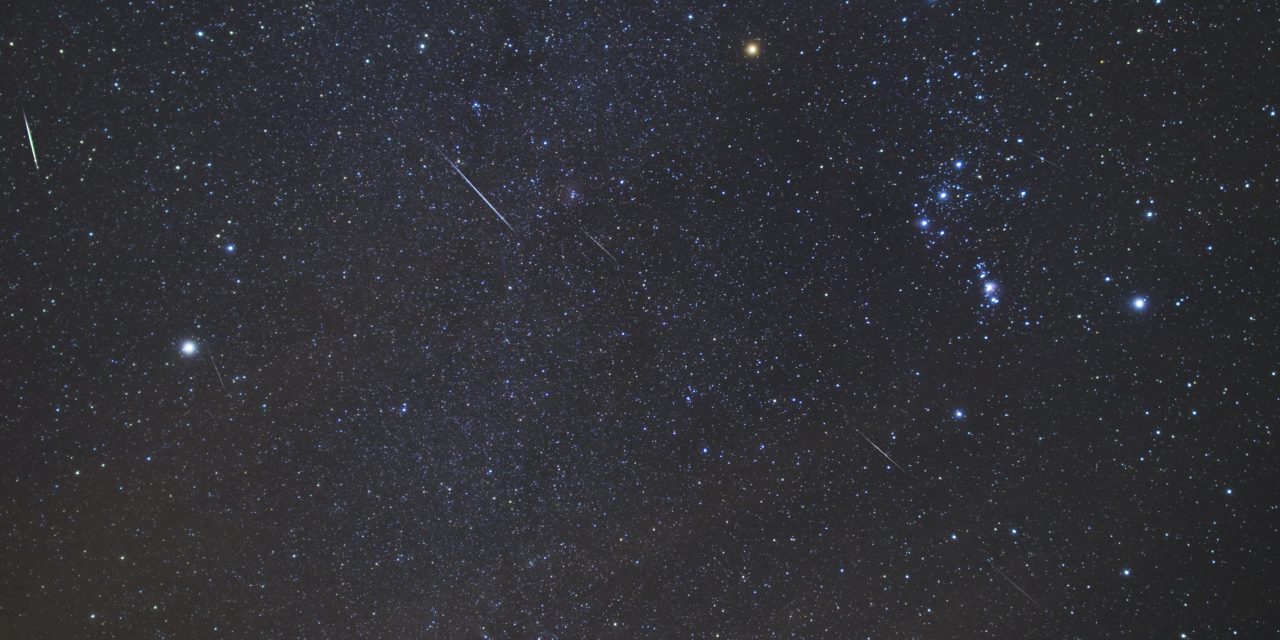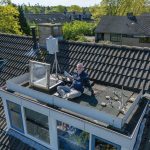Observing sessions can occasionally be a big test of patience and bound to fail from time to time! I attempted two meteor sessions in early December but they were both a bust due to poor weather. The first was for the possible Andromedids activity on December 5/6; I drove two hours out of Ottawa to the L&A Dark Sky Site in an attempt to get some clear skies. It was more than halfway cloudy when I arrived, but I was still able to casually see two nice Geminids (but no Andromedids). Before long, the sky clouded over entirely and no formal observations were possible.
On December 10, I drove to the RASC’s Fred Lossing Observatory near Almonte late at night to start observing the Geminids. The weather predicted a good clearing sky after midnight but unfortunately this never did happen. I napped inside the warm room and checked on the sky once in a while, but it stayed completely solid overcast. It wasn’t until I started driving home before dawn that the sky cleared, it was too late.
The weather finally looked much more promising for the night of December 12/13, just one night before the Geminids peak! Raymond Dubois joined me for a road trip north of Ottawa, where the prospect for a good transparency was best. We drove about 1.5 hours north, stopping for dinner in Gracefield and then on to the Blue Sea Lake area. We checked out a potential observing site at a public parking lot, but it was brightly lit and that was a no-go. We drove a bit further and found a boat ramp overlooking Lac Morissette with a perfect view of the southern sky! We setup right there on the frozen lake. It was a frigid night with a forecast low of -26C (-15F), so we took our time getting many layers of warm clothes on and then setup our cameras. The sky was nice and clear with the exception of some ice fog and distant high cirrus. Overhead, the winter stars and Milky Way were beautiful — and the Geminids were active! After two “false start” sessions, it was nice to finally get a clear sky!
I got my Star Adventure mount tracking with my two DSLR cameras on top (one equipped with a 24mm f/1.4 lens and the other with a 70-200mm f/4). I settled down into my lawn chair and winter sleeping bag out onto the frozen lake. It was eerie hearing the cracks, pops and other strange sounds emitted by the ice underneath me, due to the cold. Raymond opted to watch from closer to the dock than where I was positioned. At one point, I felt the whole ice settle down with a THUMP and it had me a tad bit nervous. But all was well as long as nothing cracked underneath me. I pulled my 9×63 binocs to take a look at Comet 46P/Wirtanen near its best. It was very easy to pick up the concentrated fuzz ball in the 9x63mm binocs, and then I was able to just barely make it out to the unaided eyes.
I signed on for meteors at 12:40am EST and went on until 6:15am. I took a number of breaks during the night (to attend cameras mostly), so the actual session was nearly four and a half hours of effective time. During that time, I saw 256 meteors (210 Geminids, 8 Monocerotids, 7 Hydrids, 4 December Leo Minorids, 3 Antihelions, 3 December Alpha Draconids and 21 sporadics). It was indeed a very active night, with higher than expected numbers. My hourly rates for the Geminids were 48, 67, 47 and 42. The second hour was especially great as the radiant crossed the meridian. Many of the meteors were on the faint side (typical during the pre-peak night). There was many mag +2s, +3s and +4s, however the final hour of the night produced some brighter meteors. The most impressive was a -3 Geminid at 3:11am EST that scooted through the head of Hydra and left a 2 sec train. Brighter Geminids were typically white, slightly bluish or yellowish. Only 2% of Geminids left a visible train.
All in all, a really good, productive … but cold night!! It was nice having Raymond along for company, but we were quite frozen when we left. The last hour was very humid with the kind of cold that went right through our parkas and through the bones. Unfortunately, the peak night of the Geminids was completely clouded out. So I was glad that we made a good effort to go out on this night. The green “Christmas comet” was a treat too. Here’s my photos:

Geminids in the winter sky, above Lake Morisette
Composite image of 21 Geminids captured on the night of December 12/13 2018. Blue Sea region, Quebec. Canon 6D, ISO 1600, Rokinon 24mm f/1.4 (set at f/2.0). Some cirrus and sky fog created slight halo effects around the brighter stars.

Geminid meteors meet Comet 46P/Wirtanen
Composite image of 6 Geminids. December 12/13 2018. Blue Sea, Quebec. Canon 5D, ISO 1600, Canon 70-200 f/4.0 (set at 135mm).

Geminid and the Beehive Cluster (M44)
December 12/13 2018. Blue Sea, Quebec. Canon 5D, ISO 1600, Canon 70-200 f/4.0 (set at 135mm).

Faint Geminid in Orion
December 12/13 2018. Blue Sea, Quebec. Canon 5D, ISO 1600, Canon 70-200 f/4.0 (set at 135mm).

Comet 46P/Wirtanen late at night
December 12/13 2018. Blue Sea, Quebec. Canon 5D, ISO 1600, Canon 70-200 f/4.0 (set at 135mm).
Visual data:
December 12/13 2018, 05:40-11:15 UT (00:40-06:15 EST)
Location: Blue Sea Lake, Quebec, Canada
(Long: -76.11° W; Lat: 46.22° N)
Observed showers:
Antihelions (ANT) – 06:08 (092) +32
Monocerotids (MON) – 07:04 (106) +08
alpha Hydrids (AHY) – 07:21 (110) -04
Geminids (GEM) – 07:41 (115) +32
sigma Hydrids (HYD) – 08:48 (132) +01
December Leonis Minorids (DLM) – 10:22 (156) +32
December sigma Virginids (DSV) – 13:30 (203) +05
05:40-6:45 UT (00:40-01:45 EST); 3/5 trans; F 1.00; LM 6.43; facing S50 deg; teff 1.08 hr, temp -18C
GEM: forty-eight: 0(3); +1(2); +2(11); +3(9); +4(11); +5(12)
ANT: two: +3(2)
MON: two: +3(2)
DLM: one: +4
Sporadics: five: +3(2); +4(3)
Total meteors: Fifty-eight
07:25-08:25 UT (02:25-03:25 EST); 3/5 trans; F 1.00; LM 6.48; facing SSW50 deg; teff 1.00 hr, temp -20C
GEM: Sixty-seven: -3; 0(4); +1(5); +2(19); +3(11); +4(20); +5(7)
MON: two: +3(2)
DAD: two: +2(2)
HYD: one: +3
DLM: one: +4
Sporadics: three: +1; +5(2)
Total meteors: Seventy-six
08:25-09:50 UT (03:25-04:50 EST); 3/5 trans; F 1.00; LM 6.50; facing SSW50 deg; teff 1.00 hr, temp -22C
GEM: forty-seven: 0; +1(4); +2(11); +3(6); +4(16); +5(9)
HYD: four: 0; +3; +4(2)
MON: three: +2; +4(2)
DLM: two: +2; +3
ANT: one: +2
DAD: one: +3
Sporadics: four: +2; +4(3)
Total meteors: Sixty-two
09:50-10:55 UT (04:50-05:55 EST); 3/5 trans; F 1.00; LM 6.50; facing SSW50 deg; teff 1.00 hr, temp -24C
GEM: forty-two: -1; 0; +1(10); +2(9); +3(12); +4(5); +5(4)
HYD: two: +1; +4
MON: one: +2
Sporadics: seven: +1; +4(3); +5(3)
Total meteors: Fifty-two
10:55-11:15 UT (05:55-06:15 EST); 3/5 trans; F 1.00; LM 6.30 (morning twilight); facing SSW50 deg; teff 0.33 hr, temp -26C
GEM: six: +1; +2(2); +3(3)
Sporadics: two: +4(2)
Total meteors: Eight
Clear skies,
Pierre Martin
Ottawa, Ontario







Once agian a nice report Pierre! I enjoyed it very much.
Regards Koen
Thank you very much Koen! Cheers! Pierre